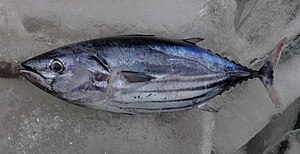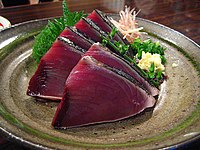Real bonito
| Real bonito | ||||||||||||
|---|---|---|---|---|---|---|---|---|---|---|---|---|

Bonito ( Katsuwonus pelamis ) |
||||||||||||
| Systematics | ||||||||||||
|
||||||||||||
| Scientific name of the genus | ||||||||||||
| Katsuwonus | ||||||||||||
| Kishinouye , 1915 | ||||||||||||
| Scientific name of the species | ||||||||||||
| Katsuwonus pelamis | ||||||||||||
| ( Linnaeus , 1758) |
The real bonito ( Katsuwonus pelamis , Japanese 鰹 Katsuo (outdated: Katsuwo ), English Skipjack tuna ) is the only species of the monotypical genus Katsuwonus within the mackerel and tuna (Scombridae). The bonito lives in tropical and subtropical seas, but is occasionally caught in the North Sea in summer . It is absent in the eastern Mediterranean and the Black Sea.
The loggerhead bonito ( Auxis thazard ) resembles it, but its meat is considered less valuable.
features
The bonito usually reaches a length of 80 cm FL (fork length, measured to the end of the middle caudal fin rays), a maximum of 110 cm FL, a weight of 34.5 kg and an age of 12 years. Its back is dark blue-violet. The lower sides and the belly are silver in color, four to six conspicuous dark bands run lengthways here, which in living animals can appear as rows of dark spots. There is no swim bladder . The process between the pelvic fins (pelvic process, interpelvic process) is small and divided into two parts. With the exception of the corselet (area behind the head and the pectoral fin) and the side line, the body is not scaly.
The bonito has 41 vertebrae. The first dorsal fin is supported by 14 to 16 hard rays. The second dorsal fin with 14 to 15 soft rays is narrowly separated from the first, the distance is not greater than the diameter of the eye. The second dorsal fin is followed by 7 to 9 finlets (special small, radiationless fins along the caudal peduncle). The anal fin is supported by 14 to 15 soft rays, followed by 7 or 8 finlets.
Habitat and way of life
Real bonitos live epipelagically off the coasts in the free ocean. Adults occur in water temperatures of 14.7 to 30 ° C, while the larvae are mostly restricted to water bodies with surface temperatures of at least 25 ° C. Aggregations often form at the boundaries of cold and warm water masses. During the day they stay from the surface to depths of 260 m, at night they prefer to be close to the surface. Spawning takes place in spurts, in equatorial waters all year round, in subtropical waters from spring to early autumn, whereby the spawning season becomes shorter with increasing distance from the equator. Fertility increases with the size of the female, but it is very variable. The number of eggs per season is between 80,000 and 2 million with a length of 41 to 87 cm FL.
The bonito feeds mainly on fish, crustaceans and mollusks . Jackfish and triggerfish are also prey . His diverse diet suggests an opportunist who takes whatever food is available. Even cannibalism is common. The main times for finding food are early morning and late afternoon. The bonito, in turn, is a prey for large pelagic fish, its main predators are other tuna and spearfish .
use

The real bonito (skipjack) is one of the economically most important species marketed as "tuna", although zoologically it does not belong to the genus of the tuna ( Thunnus ), but only to the mackerel and tuna family , of which it is a close relative. It is caught close to the surface, mainly with purse seine or fishing rods , as a chance catch also on longlines . It is offered fresh, frozen or canned . In Japanese cuisine it is called Katsuobushi , i.e. H. dried and smoked , or processed as Katsuo no shiokara .
literature
- Bruce B. Collette, Cornelia E. Nauen: Scombrids of the world. An annotated and illustrated catalog of tunas, mackerels, bonitos and related species known to date (= FAO Species Catalog. Vol. 2 = FAO Fisheries Synopsis. No. 125, Vol. 2). United Nations Development Program et al., Rome 1983, ISBN 92-5-101381-0 , pp. 42-44, ( complete edition ).
Individual evidence
- ↑ a b c Real Bonito on Fishbase.org (English)
- ↑ a b c d e f FAO Fisheries & Aquaculture Species Fact Sheets: Katsuwonus pelamis (Linnaeus, 1758) ( Online )
- ↑ Katsuwonus pelamis in the IUCN Red List of Threatened Species 2013.1. Posted by: B. Collette et al. , 2011. Retrieved October 8, 2013.
- ↑ WWF background information on tuna (Thunnus spp.)
- ↑ Michael Ashkenazi, Jeanne Jacob: Food Culture in Japan. Food Culture Around the World, 2000, ISBN 978-0313324383 , p. 34.
Web links
- Real bonito on Fishbase.org (English)
- Katsuwonus pelamis inthe IUCN Red List of Threatened Species 2013.1. Posted by: B. Collette et al. , 2011. Retrieved October 8, 2013.
